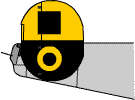History of the 460th Bomb Group
In August of 1943, the tide of battle was beginning to turn in favor of the United Nations. Our forces were beginning the invasion of Europe by driving the enemy out of Sicily; the Russians were smashing back the Nazi hordes that had invaded their homeland and Germany’s Yellow brothers-in-infamy were beginning to lose some of their blood soaked holdings as American and Australian Forces were beating them on those faraway islands of Munda, Bouganville, Rendova and Kolombangara. Then America’s forges of war-might were fiery hot and into them she was pouring the tools of vengeance to be molded and tempered for battle.
Colonel (then Lt. Col.) Robert T. Crowder, of Lawrence, Kansas, was charged with the moulding and tempering of one of those tools – the 460th Bombardment Group (Heavy).
In early August, 1943, at the Army base in Clovis, New Mexico, Col. Crowder gathered a handful of officers and enlisted men together and began the formation of this bombardment group. From this inauspicious beginning grew one of the most powerful weapons of the United States Army Air Forces.
The Black Panther, symbolic of swift, iron-clawed revenge, was chosen for the insignia of the 460th Bombardment Group and through its courageous combat history, the Group fulfilled its every mission in the fearless manner and with the same deadly technique of its namesake.
From Clovis, NM, the group moved to the Army Air Forces School of Applied Tactics, Orlando, FL, for specialized training and then on to Salt Lake City, UT, where it began to pick up ground and air crewmen to complete its organizational strength. Then, a few weeks later, moved to Chatham Army Air Field, Savannah, GA, for completion of training.
On January 1st, 1944, the Group’s airmen began taking their B-24 Liberator bombers off on the long flight to their Italian base, while the ground personnel moved to Newport News, VA, to board their Liberty ship transports which sailed in convoy on January 12th and reached Italy safely on February 13th after surviving both enemy aircraft and submarine attacks at sea.
The combat history of the 460th Bombardment Group is a proud one from the day the Group flew its first mission in March, 1944, until its last in May, 1945. Its history involves 217 bombing missions deep into enemy-held territory throughout France, Germany, Austria, Czechoslovakia, Yugoslavia, Hungary, Roumania, Greece and Italy.
For its outstanding performance in bombing the Zwolfaxing Airdrome in Vienna, Austria, on July 25th, 1944, in spite of adverse weather and through every defense, fighters and anti-aircraft fire, which the enemy could throw into the air, the 460th Bombardment Group was awarded the Distinguished Unit Citation by the War Department.
After V-E Day, the Group was moved to Natal, Brazil, where its members worked on the Green Project of the Air Transport Command, speeding the return of other veterans of the Mediterranean and European Theatres of War to their homes in the States. Then on September 26th, 1945, the 460th Bombardment Group was official inactivated under orders from the War Department.
The job for which it had come into being had been done, and done well. Through training and combat experience, a group of civilian-soldiers, guided by a handful of professional military men, had been molded into a fighting team that contributed more than its fair share toward the ultimate victorious conclusion of World War II.
Now, throughout the United States, again following their peacetime pursuits, the more than 4,000 men who had been members of the 460th Bombardment Group (H) can look back with pride on the part they played as individuals, and their Group as a team, played in the accomplishment of Victory, and look forward to the day when the necessity of the existence of such an organization will have lost all meaning.
Colonel Robert T. Crowder
of
Lawrence, Kansas
Commanding Officer of the 460th Bombardment Group
from
August 1943, to April, 1944
His intelligent guidance and courageous leadership was a source of inspiration to every officer and enlisted man under his command. In order to understand every difficulty his men had to face, he insisted on leading his Group on its first and succeeding bombing missions until on April 1944, his aircraft was mortally hit by cannon fire from enemy fighter planes. Col. Crowder struggled valiantly to keep the plane in flying altitude while his crew members tried to escape. Some of them did, but the plane got entirely out of control and Col. Crowder was killed in the ensuing crash. His tragic and heroic death was mourned by all who had known and worked with him.
He was awarded the Air Medal with one Oak Leaf Cluster and the Purple Heart posthumously and was entitled to wear the European-African-Middle East Theatre Ribbon, the American Defense Ribbon and the American Theatre Ribbon.
Colonel Bertram C. Harrison
of
Leesburg, Virginia
Commanding Office of the 460th Bombardment Group
from
April, 1944, to September, 1944
Veteran of fifty-two missions in the European-African-Middle Eastern Theatre and two bombing sorties in the China-Burma-India Theatre, Col. Harrison has been awarded the Legion of Merit, the Silver Star, the Distinguished Flying Cross with one Oak Leaf Cluster and the Air Medal with four Oak Leaf Clusters and is entitled to wear the American Defense Ribbon, the American Theatre Ribbon, the European-Middle East Theatre Ribbon with four bronze battle stars and the Asiatic-Pacific Theatre Ribbons with one bronze battle star.
Lt. Colonel Harold T. Babb
of
Dalton, Georgia
Commanding Officer of the 460th Bombardment Group
from
September – October, 1944
Lt. Col. Babb is a veteran of thirty-five bombing sorties in the European-African-Middle East Theatre and was awarded the Distinguished Flying Cross with one Oak Leaf Cluster, the Air Medal with three Oak Leaf Clusters and is entitled to wear the American Defense Ribbon, the American Theatre Riibbon and the European-African-Middle East Theatre Ribbon with five battle stars.
Colonel John M. Price
of
Fort Dodge, Iowa
Commanding Officer of the 460th Bombardment Group
from
October, 1944, to September, 1945
Veteran of twenty-three bombing sorties in the European-African-Middle East Theatre, Col. Price has been awarded the Distinguished Flying Cross, the Air Medal with one Oak Leaf Cluster and is entitled to wear the American Defense Ribbon, the American Theatre Ribbon, and the European-African-Middle East Theatre Ribbon with six bronze battle stars.

